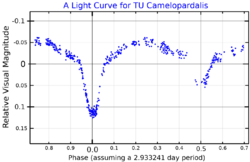Astronomy:31 Camelopardalis
| Observation data Equinox J2000.0]] (ICRS) | |
|---|---|
| Constellation | Camelopardalis |
| Right ascension | 05h 54m 57.82481s[2] |
| Declination | +59° 53′ 18.1314″[2] |
| Apparent magnitude (V) | 5.20[3] |
| Characteristics | |
| Spectral type | A2V[4] (A0IV + F0)[5] |
| U−B color index | +0.03[6] |
| B−V color index | +0.010[3] |
| Variable type | β Lyr[7] |
| Astrometry | |
| Radial velocity (Rv) | −2.9±0.9[8] km/s |
| Proper motion (μ) | RA: +1.488[2] mas/yr Dec.: −17.928[2] mas/yr |
| Parallax (π) | 7.1562 ± 0.2336[2] mas |
| Distance | 460 ± 10 ly (140 ± 5 pc) |
| Orbit[9] | |
| Period (P) | 2.9333 d |
| Eccentricity (e) | 0.00 |
| Longitude of the node (Ω) | 0.00° |
| Periastron epoch (T) | 2,423,443.05±10.00 JD |
| Semi-amplitude (K1) (primary) | 78.0 km/s |
| Details | |
| 31 Cam A | |
| Mass | 3.03±0.08[10] M☉ |
| Luminosity | 179.8+31.7 −26.9 L☉ |
| Temperature | 9,183+149 −147 K |
| Rotational velocity (v sin i) | 75[10] km/s |
| Other designations | |
| Database references | |
| SIMBAD | data |
31 Camelopardalis is a binary star system in the northern circumpolar constellation of Camelopardalis. It is visible to the naked eye as a dim point of light with a peak apparent visual magnitude of +5.12.[7] Parallax measurements provide a distance estimate of approximately 460 light years away from the Sun,[2] and the system is drifting closer to the Earth with a radial velocity of −3 km/s.[8]
This is a single-lined spectroscopic binary in a circular orbit with an orbital period of 2.93 days.[9] It is a detached binary with two main sequence components that do not fill their Roche lobes. The orbital plane is oriented near the line of sight from the Earth, making this a Beta Lyrae–type eclipsing binary variable star. It has the variable star designation TU Cameleopardis, while 31 Camelopardalis is the Flamsteed designation.[4] The primary eclipse lowers the visual magnitude to 5.29, while the secondary eclipse lowers it to 5.22.[7]
References
- ↑ West, Richard M. (January 1968). "Light-curves and elements of the eclipsing binary TU Cam". Bulletin of the Astronomical Institutes of the Netherlands Supplement 2: 259–276. Bibcode: 1968BANS....2..259W.
- ↑ 2.0 2.1 2.2 2.3 2.4 2.5 Brown, A. G. A. (August 2018). "Gaia Data Release 2: Summary of the contents and survey properties". Astronomy & Astrophysics 616: A1. doi:10.1051/0004-6361/201833051. Bibcode: 2018A&A...616A...1G. Gaia DR2 record for this source at VizieR.
- ↑ 3.0 3.1 Anderson, E.; Francis, Ch. (2012). "XHIP: An extended hipparcos compilation". Astronomy Letters 38 (5): 331. doi:10.1134/S1063773712050015. Bibcode: 2012AstL...38..331A.
- ↑ 4.0 4.1 4.2 "31 Cam". SIMBAD. Centre de données astronomiques de Strasbourg. http://simbad.u-strasbg.fr/simbad/sim-basic?Ident=31+Cam.
- ↑ Mezzetti, M. et al. (1980). "Revised photometric elements of eight eclipsing binaries". Astronomy and Astrophysics Supplement Series 42: 15–22. Bibcode: 1980A&AS...42...15M.
- ↑ Mermilliod, J.-C. (1986). "Compilation of Eggen's UBV data, transformed to UBV (unpublished)". Catalogue of Eggen's UBV Data. Bibcode: 1986EgUBV........0M.
- ↑ 7.0 7.1 7.2 Avvakumova, E. A. et al. (October 2013). "Eclipsing variables: Catalogue and classification". Astronomische Nachrichten 334 (8): 860. doi:10.1002/asna.201311942. Bibcode: 2013AN....334..860A.
- ↑ 8.0 8.1 Wilson, Ralph Elmer (1953). "General catalogue of stellar radial velocities". Carnegie Institute Washington D.C. Publication. Bibcode: 1953GCRV..C......0W.
- ↑ 9.0 9.1 "Spectroscopic binaries with circular orbits.". Astronomical Journal 76: 544–556. August 1971. doi:10.1086/111159. Bibcode: 1971AJ.....76..544L.
- ↑ 10.0 10.1 Zorec, J.; Royer, F. (January 2012). "Rotational velocities of A-type stars. IV. Evolution of rotational velocities". Astronomy & Astrophysics 537: A120. doi:10.1051/0004-6361/201117691. Bibcode: 2012A&A...537A.120Z.
 |


